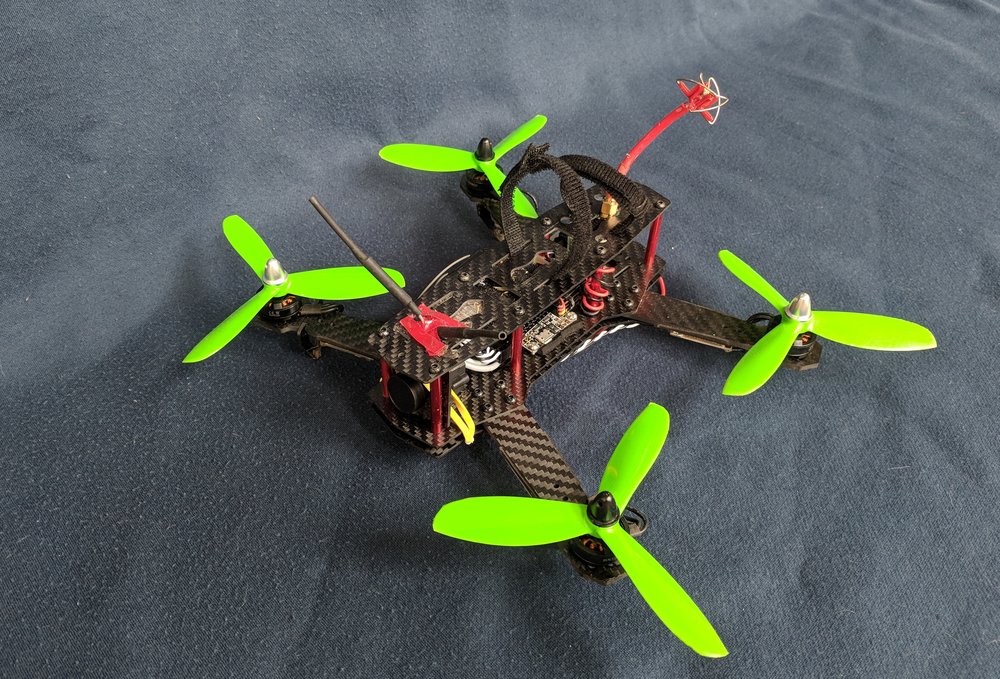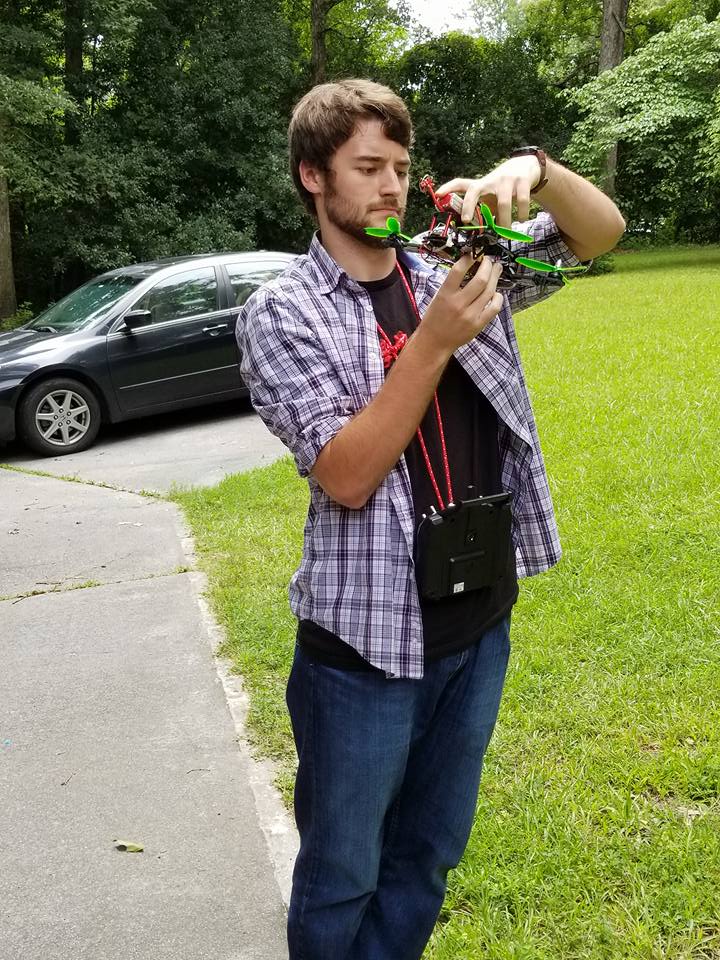Racing Drone


OBJECTIVE
I wanted to create a drone that was, at a minimum, capable of sustaining flight. Some slightly more difficult objectives include flying in first person mode and possibly doing a flip?
LIMITATIONS
Because this wasn’t for a competition or anything, the only limitations I have are ones that nature has put on me. I need the drone to be light and fast, as well as having a decent enough battery life to practice my pilot skills.
So, going into this project, I had no idea about how drones work or fly or do anything, so I needed to do a whole heck of a lot of research. I started with some youtube videos about the general concept of drone building, whether I wanted to build one from scratch or buy a kit, those kinds of things. I found this video a pretty good one that explained the general concept: https://www.youtube.com/watch?v=a8JyCGXrFbk.
After the research phase was over, I decided that I wanted to pick out individual parts and put them all together because 1. I thought it would be more challenging, and 2. I wanted the drone to max flight time for a loss of speed. I thought that for a first drone I would be better off getting more flight time to learn how it controls than going top speeds. There are a few different parts that every FPV drone needs: Motors & ESCs, FPV camera & video transmitter, controls transmitter/receiver, and a flight controller.
First up, the motors and ESCs. ESC stands for electronic speed controller; it basically receives input from the flight controller and tells the motors how fast to spin. The motors used in drone building are what are called brushless motors. There are some funky differences in the physical building of the brushless motors vs brushed motors, but I’ll just talk about the pros and cons. Typically brushless motors cost more and controls are a bit more complex because you need an ESC to control the motor. The motors themselves have three terminals as opposed to brushed which only have two. You cannot just attach a battery to brushless motors like you can with brushed. The ESC tells which of the three terminals need to be constantly changing to spin at the desired rate. So you may be asking why use brushless if they are so much more complicated to use? The answer to that is they are super high efficiency and can spin extremely fast, which is very useful for getting things to fly.


Lets talk about the ESC for a second and how it works. So, the ESC expects a specific type of signal from the flight controller so that it knows how fast to spin the motor. it is expecting what is called a Pulse Width Modulation (PWM) signal. In simple terms it is a percentage of a time period. So, different ESCs require different “duty cycles” or lengths of time. Lets say for simplicities sake that my ESCs have a 1 second duty cycle (typically it is around 2 milliseconds). If I want to tell my motors to spin at half speed, I would send to the ESC a 5v signal for .5 seconds and then a 0v signal for .5 seconds. These time periods always add up to 1 second. Another example, if I wanted my motors to spin at 20% of their full speed, I would send a 5v signal for .2 seconds followed by a 0v signal for .8 seconds. So, the esc is just expecting a percentage of how much power to give the motors based off of how long that 5v signal is. Now, like I said earlier, a typical duty cycle is around 2 milliseconds or so, and this happens much faster.
Now the camera and video transmitter. These two are pretty simple, you need something that captures video (a camera), something that sends video (a transmitter), something that receives video (a receiver), and something to display that on (a screen). So, how does it all work? Well, the camera takes the footage that it is getting and sends it through a wire to the transmitter which transmits that signal on a frequency. Most pilots use 5.8GHz to transmit video. Then the receiver, which is on the same channel, picks up that signal and sends it to a headset where you can see the live footage.
Next up, the controls transmitter and receiver. So, these guys work in the same way as the video, except the pilot is the one doing the sending and the drone does the receiving. There’s just a transmitter and a receiver that communicate with each other, then the receiver spits the signals into the flight controller.
Speaking of the flight controller, let’s talk about the most important piece of this expensive puzzle. The flight controller is the brains of the whole operation. Its main function is to take in signals from the receiver and tell the ESCs how they should spin the motors. There are many different flight controllers out there, but most of them use the same software. The two main ones I found are cleanflight and betaflight. I used betaflight for my drone because it had updated firmware for my drone that cleanflight didn’t have. These programs allow you to customize your drone to your liking. You can set the failsafe procedure, different flight modes, and all sorts of fun stuff in there. I set my drone up with a kill switch and three separate flight modes. One that was baby learns to fly mode (angle), the next was you’re ok with turning a bit mode (horizon), and the last was you’re never going to master this one mode (rate). These were super fun to play around with and I recommend you spend some time reading up on what each one means if you’re interested.
So, everything is built, primed and ready, what happens next? Now, we fly! I was actually able to achieve flight on my first go, which was very surprising to me, as I expected a much more difficult start. The main issue that arose was wet grass. Dew kept getting into the center area of the drone and shorted out some stuff once, so I took some hot glue and applied it over the exposed electrical components as an insulator and that seemed to do the trick. After that it was pretty smooth sailing. I haven’t had any major crashes that have brought my drone flaming to the ground yet.
FUTURE IMPROVEMENTS
The biggest thing I found with this drone is that everything was separate from each other. What I mean by that is they make some very compact flight controllers that have other pieces built into them as well as frames with spaces for hidden wires to be routed through. So, if I’m going to make another I will definitely spring for better integration between systems. They also make flight controllers that can display information on your video feed with something called an On Screen Display (OSD) which would be really handy to have. All in all though, I have a working machine that I can fly around with, which I am on board with!

